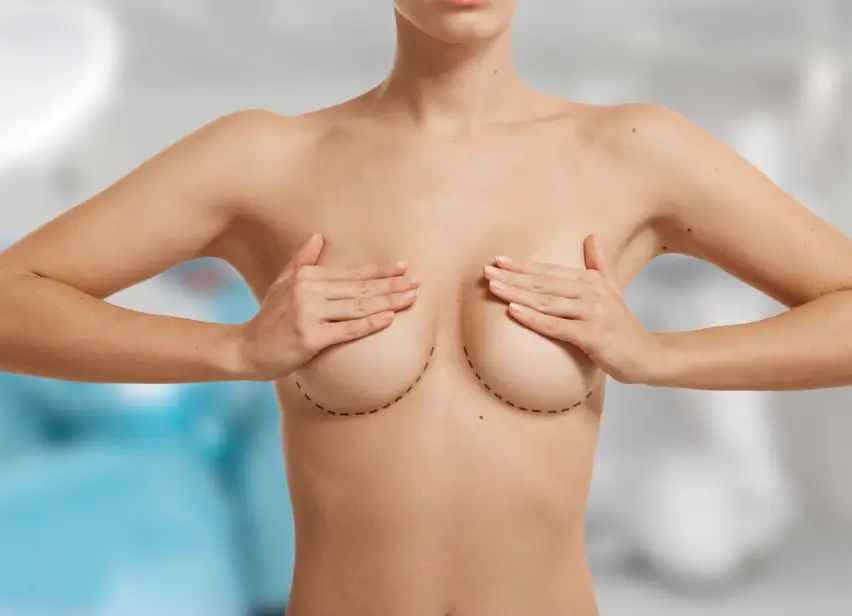
What is Breast Reconstruction?
Options for Breast Reconstruction
Prosthetic-Based Reconstruction
Prosthetic-based reconstruction involves the use of tissue expanders and implants to rebuild the breast.
- Step 1: Tissue Expansion
- A temporary tissue expander is placed under the chest muscle and gradually filled with saline over several weeks to stretch the skin and create space for the implant.
- Step 2: Implant Placement
- Once the skin is adequately prepared, the expander is replaced with a silicone or saline implant for the final reconstruction.
Benefits of Prosthetic-Based Reconstruction:
- Shorter surgical time compared to autologous methods.
- Suitable for patients without sufficient donor tissue.
- High-quality implants provide natural shape and feel.
- Step 1: Tissue Expansion
Autologous Reconstruction with Local and Regional Perforator Flaps
Autologous reconstruction uses the patient’s own tissue to recreate the breast. Local and regional perforator flaps involve transferring tissue from nearby areas while preserving the muscle at the donor site, reducing morbidity.
Common Perforator Flap Techniques:
- LICAP (Lateral Intercostal Artery Perforator) Flap: Tissue from the side of the chest is used to reconstruct the breast.
- TDAP (Thoracodorsal Artery Perforator) Flap: Tissue from the back is harvested while sparing the underlying muscle.
Benefits of Local and Regional Perforator Flap Reconstruction:
- Maintains donor site functionality by sparing muscles.
- Provides a natural look and feel with long-lasting results.
- Ideal for patients with moderate tissue requirements.
Microsurgical Free Flap Reconstruction
For patients seeking advanced autologous options, microsurgical free flap reconstruction is an excellent choice. This specialised technique involves transferring tissue from a distant site to the chest, reconnecting blood vessels using precise microsurgery to ensure tissue viability.
Common Free Flap Techniques:
- DIEP Flap (Deep Inferior Epigastric Perforator): Tissue is taken from the abdomen without sacrificing abdominal muscles.
- TUG Flap (Transverse Upper Gracilis): Tissue from the inner thigh is used for reconstruction.
- SGAP/IGAP Flap (Superior/Inferior Gluteal Artery Perforator): Tissue from the buttocks is transferred to the breast area.
Benefits of Microsurgical Free Flap Reconstruction:
- No need for implants; uses natural tissue.
- Superior aesthetic outcomes with natural contour and texture.
- Long-lasting results with minimal impact on donor site function.

Why Choose Prof Chrysis Sofianos for Breast Reconstruction?
Prof Chrysis Sofianos brings extensive expertise in breast reconstruction, including specialised training through a microsurgical fellowship for free flap reconstruction. His advanced skills and patient-centred approach ensure optimal outcomes, whether you choose implant-based, autologous, or microsurgical techniques.
- Microsurgical Expertise: Highly trained in complex free flap procedures for natural, long-lasting results.
- Personalised Care: Tailored treatment plans based on your unique needs and preferences.
- Comprehensive Approach: From consultation to recovery, Prof Sofianos and his team provide expert guidance and compassionate care.
When to Consider Breast Reconstruction
Breast reconstruction may be an option for women who have undergone:
- Mastectomy or partial mastectomy for breast cancer.
- Preventive mastectomy due to genetic predisposition (e.g., BRCA1/BRCA2 mutations).
- Surgery resulting in significant breast deformities.
Benefits of Breast Reconstruction
- Restores Confidence: Helps you feel whole again after breast surgery.
- Customised Solutions: Choose from a range of techniques to match your needs.
- Natural Results: Advanced techniques ensure aesthetic and functional outcomes.
- Improved Quality of Life: Enhances body image and self-esteem.
Your Breast Reconstruction Journey
1. Personalised Consultation
During your consultation, Prof Sofianos will:- Review your medical history and discuss your goals.
- Assess your suitability for implant-based or autologous reconstruction.
- Explain the surgical options, recovery process, and expected outcomes.
2. Surgical Procedure
Reconstruction is performed under general anaesthesia, with surgical time varying depending on the technique used.3. Recovery and Results
- Downtime: Most patients return to light activities within 2–4 weeks.
- Healing: Swelling and bruising subside over several weeks.
- Final Results: Become fully apparent within 3–6 months as healing progresses.
FAQs About Breast Reconstruction
1. Can breast reconstruction be done immediately after mastectomy?
Yes, immediate reconstruction can be performed during the same surgery as the mastectomy. However, delayed reconstruction is also an option.
2. Which is better: implants or autologous reconstruction?
The choice depends on your anatomy, lifestyle, and preferences. Prof Sofianos will guide you in selecting the best option.
3. How long does a microsurgical free flap procedure take?
Microsurgical free flap reconstruction typically takes 6–8 hours, depending on the complexity of the case.
4. Will I need multiple surgeries?
In some cases, additional procedures may be required to refine the results or address symmetry.
Table of Contents
Reclaim your confidence with advanced breast reconstruction at Prof Chrysis Sofianos Plastic Surgery Johannesburg. Whether you’re considering prosthetic-based solutions, autologous reconstruction, or microsurgical free flaps, we’re here to guide you every step of the way.
